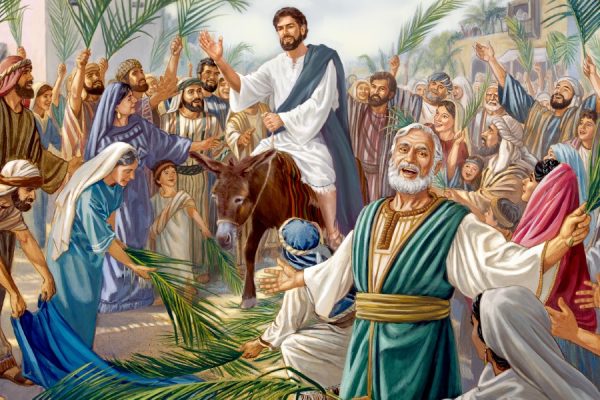Home>Christian Resources>Daniels 70th Week: Future or Fulfilled


Christian Resources
Daniels 70th Week: Future or Fulfilled
Published: December 4, 2019
Bringing you the theory that Daniel's 70th week was fulfilled, we explain how the first 69 weeks in Daniel proves the fulfillment of Jesus' prophecies.|Bringing you the theory that Daniel's 70th week was fulfilled, we explain how the first 69 weeks in Daniel proves the fulfillment of Jesus' prophecies.
(Many of the links in this article redirect to a specific reviewed product. Your purchase of these products through affiliate links helps to generate commission for Christian.net, at no extra cost. Learn more)
This material is used by permission from Ralph Woodrow, P.O. Box 124, Riverside, CA 92502
THE SEVENTIETH WEEK: FUTURE OR FULFILLED?
“Seventy weeks are determined upon thy people and upon thy holy city, to finish the transgression, and to make an end of sins, and to make reconciliation for iniquity, and to bring in everlasting righteousness, and to seal up the vision and prophecy, and to anoint the most Holy.
“Know therefore and understand, that from the going forth of the commandment to restore and to build Jerusalem unto the Messiah the Prince shall be seven weeks, and threescore and two weeks: the street shall be built again, and the wall, even in troublous times.
“And after threescore and two weeks shall Messiah be cut off, but not for himself, and the people of the prince that shall come shall destroy the city and the sanctuary; and the end thereof shall be with a flood, and unto the end of the war, desolations are determined.
“And he shall confirm the covenant with many for one week: and in the midst of the week he shall cause the sacrifice and the oblation to cease, and for the overspreading of abominations he shall make it desolate, even until the consummation, and that determined shall be poured upon the desolate” (Daniel 9:24-27).
This great prophecy pertaining to Daniel’s people and the city of Jerusalem is linked with a time period of seventy “weeks.” Bible students recognize that these seventy weeks or 490 days are symbolic of years each day representing a year that is 490 years.
It was this same year-for-a-day principle that was used in Numbers 14:34. Because of unbelief, the Israelites were to wander for 40 years in the wilderness, a year for each day that the spies were absent searching out the land. This same scale was used in Ezekiel 4:4-6: “I have appointed thee a day for a year, a day for a year.”
While Christians are generally united in the belief that the “seven weeks, and threescore and two weeks”, that is, 69 weeks (483 years) measured unto “Messiah”, concerning the final week of the prophecy, the 70th week, there are two entirely different interpretations that are held today the FUTURIST interpretation and the FULFILLED interpretation.
The futurist interpretation is that a huge gap of 2,000 years or so separates the 70th week from the other 69 weeks that measured unto Messiah. The fulfilled interpretation is that no gap is to be placed between the 69th week and the 70th-that the 70th week followed the 69th in logical sequence.
The futurist interpretation is that the 70th week refers to the Antichrist who will make a covenant with the Jews. This covenant will allow them to offer sacrifices in a “rebuilt” temple at Jerusalem for seven years, but after three and a half years he will break this covenant and cause the sacrifices to cease. The fulfilled interpretation, on the other hand, is that the 70th week refers to Christ and that the causing of the sacrifices to cease was accomplished at Calvary when Christ became the final and perfect sacrifice for sin.
What differences exist here! One says the 70th week is future; the other says it is fulfilled! One says there is a huge gap between the 69th and the 70th weeks; the other requires no gap. One says the 70th week pertains to Antichrist; the other to Jesus Christ! In view of such glaring differences, both of these interpretations simply cannot be correct.
We believe the fulfilled interpretation is the correct view; that the 69 weeks measured “unto Messiah”; that in the midst of the 70th week after three and a half years of ministry, he was cut off in death; that this sacrifice, being the perfect sacrifice, caused other sacrifices to cease in God’ s plan. Let us now notice step by step all of the basic parts of the 70 weeks prophecy and how these things were fulfilled.
I. JERUSALEM WAS TO BE RESTORED. We have already seen the scriptures that explain this.
2. THE STREET AND WALL WERE TO BE REBUILT IN TROUBLOUS TIMES. We have seen in the book of Ezra some of the troubles that confronted the people in those years of rebuilding.
3. THE MOST HOLY WAS TO BE ANOINTED. We believe this reference is to Jesus Christ. Gabriel announced to Mary: “The HOLY thing that shall be born of thee shall be called the Son of God” (Luke 1:35). Peter referred to him as “the HOLY ONE” (Acts 3:14). John referred to him as “the HOLY ONE” (1 John 2:20). Even demons had to recognize him as “The HOLY ONE of God” (Mark 1:24).
David spoke concerning Christ: neither wilt thou suffer thine HOLY ONE to see corruption” (Acts 2:27). In Revelation 3:7 he is called “HOLY” and the heavenly creatures rest not from saying: “HOLY, HOLY, HOLY” before this one “which was, and is, and is to come” (Revelations 4:8).
From the going forth of the commandment to restore and build Jerusalem unto Messiah was to be 483 years. When this time was fulfilled, those who knew this prophecy were expecting the appearance of the Messiah, that is, the Christ. (Christ is the Greek form of the Hebrew word Messiah.) Thus when John came baptizing, “the people were in EXPECTATION, and all men mused in their hearts of John, whether he were the Christ or not” (Luke 3:15). John plainly told them that he was not the Christ óhe was only the forerunner. When Jesus appeared on the scene, John cried: “Behold the Lamb of God”! The time had now come that Jesus should be “made manifest to Israel” (John 1:29 31). He was then baptized and when he had prayed, “the heaven was opened. And the Holy Ghost descended in a bodily shape like a dove upon him, and a voice from heaven, which said, Thou art my beloved Son; in thee I am well pleased” (Luke 3:21,22).
He had appeared to Israel right on time! Thus Jesus, in evident reference to the time prophecy of Daniel, said: “The TIME is fulfilled” (Mark 1:15) and as the Messiah, the Christ, the “anointed one”, he preached the gospel. When he entered the synagogue of Nazareth, he announced: “The Spirit of the Lord is upon me because he hath ANOINTED me” (Luke 4:18-22). Acts 4:27 mentioned Jesus as the “holy” one that the Lord “ANOINTED.” And Peter mentioned that “God ANOINTED Jesus of Nazareth with the Holy Ghost… who went about doing good, healing all who were oppressed of the devil” (Acts 10:38).
Daniel’s prophecy revealed that the time period unto the Messiah would be 69 weeks (483 years). This measured to the time when Jesus was baptized and anointed to begin his ministry as the Messiah, the Christ, the “Anointed One.
4. MESSIAH WAS TO BE CUT OFF. The 69 weeks (7 plus 62) were to measure unto Messiah “and AFTER” the 69 weeks “shall Messiah be cut off.” Now “AFTER” 69 weeks does not and cannot mean “in” or “during” the 69 weeks! If Messiah was to be cut off AFTER the 69 weeks, there is only one week left in which he could have been “cut off” the 70th week! after three and a half years of ministry.
The term “cut off” implies that Messiah would not die a natural death; he would be murdered! So also had Isaiah prophesied using an equivalent word: “He was cut off out of the land of the living” (Isaiah 53:8).
The details about how Messiah was “cut off” are given in the gospels.
5. “TO FINISH THE TRANSGRESSION”, or literally, “to finish transgression.” As Jesus was dying, he cried: “It is FINISHED.” At Calvary, Jesus finished transgression by becoming sin for us. No future sacrifice can ever finish transgression; it was finished at Calvary (Hebrews 9:15). “He was wounded for our TRANSGRESSIONS” (Isaiah 53:5).
6. “TO MAKE AN END OF SINS.” Here the basic thought is repeated. If we understand the glorious significance of what was accomplished at Calvary, we know that here there was truly an end made of sins.
Jesus, who came “to save his people from their sins”, accomplished this when he “put away sin by the sacrifice of himself” (Mt. 1:21; Heb. 9:26). “It is not possible that the blood of bulls and of goats should take away sins… But this man, after he had offered one sacrifice for sins forever…hath perfected for ever them that are sanctified…And their sins… remember no more” (Hebrews 10:4-11). The old system of sacrifices could never make an end of sins, but Christ by the sacrifice of himself did make an end of sins, even as the prophecy had said!
John announced him as “the Lamb of God, which taketh away the sins of the world” (John 1:29). “Christ died for our sins” (1 Corinthians 15:3). He “bare our sins in his own body on the tree” (l Peter 2:24) and “hath once suffered for sins” (3:18). “He was manifested to take away our sins” (l John 3:5). This “end of sins” was accomplished at Calvary.
All of this does not mean, of course, that right at this point men quit sinning. This was not the case. But what the scripture does mean is that at Calvary the eternal sacrifice for sin was made, so that any and allópast, present, or future ówho will be forgiven of sins will be forgiven because our Lord’ s death almost 2,000 years ago made an “end of sins”!
7. “TO MAKE RECONCILIATION FOR INIQUITY.” The word reconciliation used here is the same word that is used so frequently in the book of Leviticus where it is rendered “to make atonement.” This, too, was part of our Lord’s redemptive work. Surely “reconciliation” is a present reality because of Calvary!
Jesus, “our merciful and faithful high priest” made “RECONCILIATION for the sins of the people” (Hebrews 2:17). “Having made peace through the blood…to RECONCILE all things unto himself…and you, that were sometimes alienated…hath he RECONCILED…through death” (Colossians. 1:20-22; Ephesians. 2:16).
“God was in Christ, RECONCILING the world unto himself, not imputing their trespasses unto them; and hath committed unto us the word of RECONCILIATION” (2 Corinthians 5:19). Plainly, “reconciliation for iniquity” was accomplished by Jesus, for he “gave himself for us, that he might redeem us from all INIQUITY” (Titus 2:14), and “the Lord hath laid on him the INIQUITY of us all” (Isaiah 53:6).
8. ”TO BRING IN EVER LASTING RIGHTEOUSNESS.” This too was accomplished by the redemptive work of Christ! The great redemption chapter of Isaiah 53 had prophesied: “My righteous servant shall make many RIGHTEOUS.” Paul put it this way: “By the righteousness of one…shall many be made RIGHTEOUS… unto eternal life by Jesus Christ” (Romans 5:17-21). He who came “to fulfill all righteousness” (Matthew 3:15) and who “loved righteousness, and hated iniquity”, was “anointed” of God (Hebrews. 1:9) and made unto us wisdom, and RIGHTEOUSNESS, and sanctification, and redemption” (1 Corinthians. 1:30). “Who his own self bare our sins in his own body on the tree, that we, being dead to sins, should live unto RIGHTEOUSNESS” (1 Peter 2:24). “Even the RIGHTEOUSNESS of God…through the redemption that is in Christ Jesus: whom God hath set forth to be a propitiation through faith in his blood to declare his RIGHTEOUSNESS for the remission of sins” (Romans 3:21-26). “For he hath made him to be sin for us, who knew no sin; that we might be made the RIGHTEOUSNESS of God in him” (2 Corinthians 5:21). “Everyone that doeth RIGHTEOUSNESS is born of him” (1 John 2:29).
Taking all of these verses into consideration, we ask: Did Christ in his coming to earth provide righteousness through his redemptive work? All Christians acknowledge that he did. We ask then: Was not this righteousness that he brought in everlasting? Of course. Surely no Christians would deny that the righteousness of Christ is “everlasting righteousness.”
“By his own blood he entered in once into the holy place, having obtained ETERNAL REDEMPTION ” everlasting righteousness” for us” (Hebrews. 9:12). This eternal or everlasting righteousness is contrasted to the old sacrifices under the law which were only of a temporary nature. But Christ, once for all time, offered himself thus providing, as the prophecy of Daniel had said, “everlasting righteousness.”
One only has to read the great redemption passages of Romans, Corinthians, Colossians, Ephesians, and Hebrews to see how an “end” of transgressions and sins, “reconciliation for iniquity”, and “everlasting righteousness” were all accomplished at Calvary by our Lord Jesus Christ!
In view of this, we see no basis for the futurist teaching that none of these things have yet been fulfilled, but are to be linked with a supposed seventieth week at the end of the age! To teach such is contradictory and tends to take away from the glory of that great redemption of Calvary which so beautifully and completely fulfilled these prophecies!
9. “TO SEAL UP VISION AND PROPHECY”, or literally, “to seal up vision and prophet.” The use of the metaphor “to seal” is derived from the ancient custom of attaching a seal to a document to show that it was genuine (See 1 Kings 21:8; Jeremiah. 32:10, 11; cf. John 6:27; 1 Corinthians. 9:2). Christ “sealed” Old Testament prophecy by fulfilling what was written of him.
Repeatedly we read concerning him: “…that it might be fulfilled which was spoken by the prophets.” Acts 3:18 says: “Those things which God before had shewed by the mouth of all his prophets, that Christ should suffer he hath so fulfilled:” Truly Jesus fulfilled what was written in the visions and prophecies of the Old Testament concerning him, and thus he “sealed” them showed that they were genuine. ‘They are they”, he said, “which testify of me” (John 5:39). “All the prophets and the law prophesied until John” (Matthew 11:13), then John presented Jesus as he that was to be “made manifest to Israel.” Jesus was the one that was to come and we look for none other. He is the fulfillment of vision and prophecy.
10. “HE SHALL CONFIRM THE COVENANT.” When Jesus instituted the Lord’ s supper, representative of his shed blood for the remission of sins, he said: ‘This is my blood of the new testament [covenant], which is shed for many for the remission of sins” (Matthew 26:28). The word “testament” here and the word “covenant” are translated from exactly the same word in the New Testament. “How much more shall the blood of Christ…purge your conscience from dead works to serve the living God? And for this cause, he is the mediator of the new testament [covenant]” (Hebrews 9:14,15).
Jesus is called the “mediator of the new covenant” (Hebrews. 8:6), the “messenger of the covenant” (Malachi. 3:1), and his shed blood is called “the blood of the everlasting covenant” (Hebrews. 12:24). Our Lord Jesus is the one who confirmed the covenant through his redemptive sacrifice at Calvary. And how beautifully this harmonizes with what we have already seen.
11. “HE SHALL CAUSE THE SACRIFICE AND THE OBLATION TO CEASE.” This too was fulfilled in the death of Jesus Christ. In the Old Testament, as we have mentioned, sacrifices were repeatedly made. Each of these was but a mere type looking forward to the time when the perfect sacrifice, the Lamb of God, would be offered. Once this would be accomplished, God would no longer require or accept any other sacrifice.
The perfect sacrifice was Jesus Christ. The old system of repeated sacrifices (types) could only end at Calvary when Christ became the perfect, eternal, and final sacrifice (See Hebrews. 9 and 10). In addition to Calvary’s sacrifice, “there remaineth no more sacrifice for sins” (Hebrews. 10: 18, 26).
For a few more years, the Jews continued their sacrifices, but these were not recognized by God. Such cannot be termed sacrifices in the true scriptural sense of the word, for the death of Christ provided the perfect, and therefore, the final sacrifice for sins forever.
Further proof that this was fulfilled in Christ is seen in the time element, for the prophecy said that sacrifice would cease in the middle of the week the 70th week. This was when Christ died, for the 69 weeks measured unto Messiah and his death came after a ministry of three and a half years.
That this was the length of our Lord’s ministry may be seen by a study of the gospel according to John in which mention is made of four Passovers that occurred during our Lord’s ministry: John 2:13, 5:1 (see Footnote 1), 6:4, 13:1. Eusebius, a Christian writer of the fourth century, pointed these things out: “Now the whole period of our Saviour’s teaching and working of miracles is said to have been three-and-a-half years, which is half a week. John the evangelist, in his Gospel, makes this clear to the attentive.” (Footnote 2)
And so, after three and a half years of ministry as the Christ the anointed one Jesus was cut off in death, in the middle of the 70th week of seven years. As Augustine said: “Daniel even defined the time when Christ was to come and suffer by the exact date.” (Footnote 3)
Understanding this, we can now see real significance in certain New Testament statements which also speak of a definite established time at which Jesus would die. For example, we read: “They sought to take him: but no man laid hands on him, because his hour was not yet come” (John 7:30). In John 2:4, Jesus said, “Mine hour is not yet come.” On another occasion, he said, “My time is not yet come” (John 7:6). Then just prior to his betrayal and death, he said, “My time is at hand” (Matthew 26:18), and finally, ‘”the hour is come” (John 17:1; Matthew 26:45).
These and other verses clearly show that there was a definite time in the plan of God when Jesus would die. He came to fulfill the scriptures, and there is only one Old Testament scripture which predicted the time of his death the prophecy which stated that Messiah would be cut off in the midst of the 70th week at the close of three and a half years of ministry! How perfectly the prophecy was fulfilled in Christ!
But those who say that the confirming of the covenant and causing sacrifices to cease in the midst of the 70th week refers to a future Antichrist, completely destroy this beautiful fulfillment and are at a complete loss to show where in the Old Testament the time of our Lord’s death was predicted.
The prophecy of Daniel 9 stated that Messiah would confirm the covenant (or would cause the covenant to prevail) with many of Daniel’s people for the “week” or seven years. We ask then, when Christ came, was his ministry directed in a special way to Daniel’s people óto “Israel ” (Daniel. 9:20)? Yes!
John introduced him as he “that should be made manifest to ISRAEL” (John 1:31). “I am not sent”, Jesus said, “but unto the lost sheep of the house of ISRAEL” (Matthew. 15:24). And when he first sent out his apostles, they were directed: “Go not into the way of the Gentiles…go rather to the lost sheep of the house of ISRAEL” (Matthew 10:5,6).
The first half of the “week”, the time of our Lord’s ministry, was definitely directed toward ISRAEL. But what about the second half the final three and a half years of the prophecy was it also linked with Israel? Did the disciples continue to preach for the duration of the remaining three and a half years (as Christ’s representatives) especially to Daniel’s people to Israel? Yes, they did!
Jesus had told the disciples to go into all the world and preach the gospel to every creature (Mark. 16:15; Matthew.28:19; Acts 1:8), YET and this is significant after Christ ascended, the disciples still at first preached only to Israel! Why? We know of only one prophecy which would indicate that this was to be the course followed. It is the prophecy of the 70 weeks which implied that after the death of Messiah there would still be three and a half years that pertained to Israel!
Bearing this in mind, we can now understand at least one reason why the gospel went “to the Jew first” and then later to the Gentiles (Romans. 1:16). Peter preached shortly after Pentecost: “Ye are the children of the prophets, and of the covenant… unto you first God, having raised up his Son Jesus, sent him to bless you, in turning away every one of you from his iniquities” (Acts 3:25, 26). “It was necessary that the word of God should first have been spoken to you” (Acts 13:46).
In person, Christ came to Israel during the first half of the “week” three and a half years. Through the disciples for the three and a half years that remained his message still went to Israel, “the Lord working with them, and confirming the word with signs following” (Mark. 16:20). In a very real sense of the word, the ministry of the disciples was a continuation of the ministry of Christ.
Then came the conversion of Cornelius which completely changed the missionary outreach, outlook, and ministry of the church. Though the New Testament does not give an exact date when this happened, apparently the time for a special exclusive blessing upon Daniel’s people had drawn to a close. The gospel which had gone first to the Jews was now to take its full mission to be preached to all people of all nations!
This time of changeover was marked by a number of supernatural events. Cornelius received a heavenly visitation. An angel appeared to him and told him to call for Peter “who shall tell thee words whereby thou and all thy house shall be saved” (Acts 11:14). God showed Peter a vision which caused him to know that the gospel was now to go to the Gentiles and not to Israelites only. All of these things were timed perfectly showing that God’s hand was accomplishing a definite purpose.
Returning to Jerusalem, Peter explained what had happened. “When they heard these things, they… glorified God, saying, Then hath God also to the Gentiles granted repentance unto life” (Acts 11:18). From this very point, more and more, there was a turning to the Gentiles with the gospel message. God’s measurement of 490 years pertaining in a special way to Israel had obviously been completed.
And finally,
12. THE DESTRUCTION OF JERUSALEM AND THE TEMPLE. This part of the prophecy was not dated within the framework of the 70 weeks as was the time of the appearance of Messiah to Israel, the time of his death, etc. Nevertheless, living on this side of the fulfillment, we know that the predicted destruction found fulfillment in 70 A.D. when the armies of Titus brought the city to desolation.
With Adam Clarke we say: “The whole of this prophecy from the times and corresponding events has been fulfilled to the very letter.” (Clarke’s Commentary, note on Daniel 9)
(Footnotes:)
1. In this verse the feast is not mentioned by name. However, by taking John 4:35 about the “four months” into consideration, it is possible to determine that this was the feast of the passover (See Boutflower, page 208).
2. Eusebius, The Proof of the Gospel, bk. 8, chapter 2.
3. quoted in The Prophetic Faith of Our Fathers, vol. 1, page 487.
















